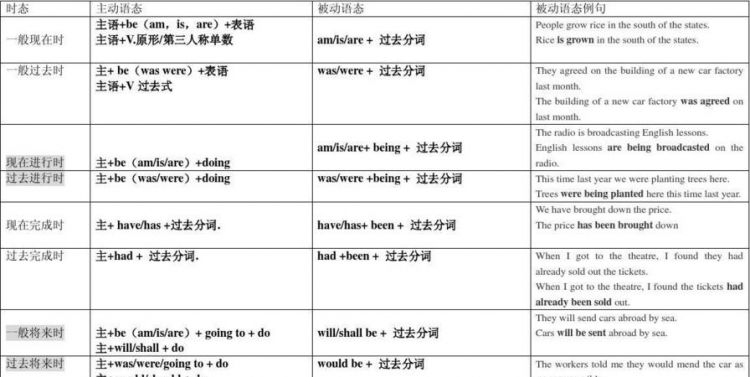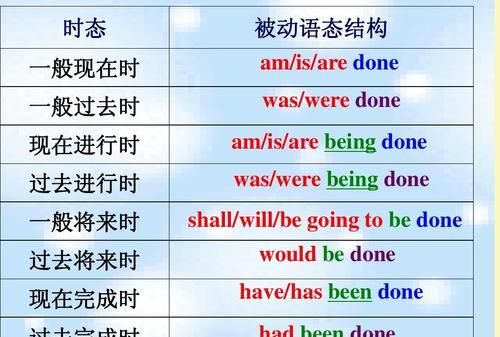本文目录
初中的被动语态涉及到的时态有哪些
英语时态分为16种:一般现在、一般过去、一般将来、过去将来时,以及这四者的进行时、完成时和完成进行时
下面就英语中常见的八种基本时态进行阐述,其它的时态都是在这八种时态的基础上结合而成的.
一、 一般现在时:
1.概念:经常、反复发生的动作或行为及现在的某种状况.
2.时间状语: always, usually, often, sometimes, every week (day, year, month…), once a week, on Sundays,
3.基本结构:动词 原形 (如主语为第三人称单数,动词上要改为第三人称单数形式)
4.否定形式:am/is/are+not;此时态的谓语动词若为行为动词,则在其前加don't,如主语为第三人称单数,则用doesn't,同时还原行为动词.
5.一般疑问句:把be动词放于句首;用助动词do提问,如主语为第三人称单数,则用does,同时,还原行为动词.
6.例句:. It seldom snows here.
He is always ready to help others.
Action speaks louder than words.
二、 一般过去时:
1.概念:过去某个时间里发生的动作或状态;过去习惯性、经常性的动作、行为.
2.时间状语:ago, yesterday, the day before yesterday, last week,last(year, night, month…), in 1989, just now, at the age of 5, one day, long long ago, once upon a time, etc.
3.基本结构:be动词;行为动词 的过去式
4.否定形式:was/were+not;在行为动词前加didn't,同时还原行为动词.
5.一般疑问句:was或were放于句首;用助动词do的过去式did 提问,同时还原行为动词.
6.例句:She often came to help us in those days.
I didn't know you were so busy.
三、 现在进行时:
1.概念:表示现阶段或说话时正在进行的动作及行为.
2.时间状语:now, at this time, these days, etc.
3.基本结构:am/is/are+doing
4.否定形式:am/is/are+not+doing.
5.一般疑问句:把be动词放于句首.
6.例句: How are you feeling today?
He is doing well in his lessons.
四、 过去进行时:
1.概念:表示过去某段时间或某一时刻正在发生或进行的行为或动作.
2.时间状语:at this time yesterday, at that time或以when引导的谓语动词是一般过去时的时间状语等.
3.基本结构:was/were+doing
4.否定形式:was/were + not + doing.
5.一般疑问句:把was或were放于句首.
6.例句:At that time she was working in a PLA unit.
When he came in, I was reading a newspaper.
五、 现在完成时:
1.概念:过去发生或已经完成的动作对现在造成的影响或结果,或从过去已经开始,持续到现在的动作或状态.
2.时间状语:recently, lately, since…for…,in the past few years, etc.
3.基本结构:have/has + done
4.否定形式:have/has + not +done.
5.一般疑问句:have或has.
6.例句:I've written an article.
The countryside has changed a lot in the past few years.
六、 过去完成时:
1.概念:以过去某个时间为标准,在此以前发生的动作或行为,或在过去某动作之前完成的行为,即“过去的过去”.
2.时间状语:before, by the end of last year(term, month…),etc.
3.基本结构:had + done.
4.否定形式:had + not + done.
5.一般疑问句:had放于句首.
6.例句:As soon as we got to the station, the train had left.
By the end of last month. We had reviewed four books
七、 一般将来时:
1.概念:表示将要发生的动作或存在的状态及打算、计划或准备做某事.
2.时间状语:tomorrow, next day(week, month, year…),soon, in a few minutes, by…,the day after tomorrow, etc.
3.基本结构:am/is/are/going to + do;will/shall + do.
4.否定形式:was/were + not; 在行为动词前加didn't,同时还原行为动词.
5.一般疑问句:be放于句首;will/shall提到句首.
6.例句:They are going to have a competition with us in studies.
It is going to rain.
八、 过去将来时:
1.概念:立足于过去某一时刻,从过去看将来,常用于宾语从句中.
2.时间状语:the next day(morning, year…),the following month(week…),etc.
3.基本结构:was/were/going to + do;would/should + do.
4.否定形式:was/were/not + going to + do;would/should + not + do.
5.一般疑问句:was或were放于句首;would/should 提到句首.
6.例句:He said he would go to Beijing the next day.
I asked who was going there .
九.将来完成时:
1.概念:在将来某一时刻之前开始的动作或状态
2.时间状语:by the time of;by the end of+时间短语(将来);by the time+从句(将来)
3.基本结构:be going to/will/shall + have done
十.现在完成进行时:
1.概念:在过去某一时刻之前开始的动作或状态一直持续到说话为止
2.基本结构:have/has +been+doing
几种常见时态的相互转换
英语中的几种时态在一定情况下可以互相转换,以下是几种常见的转换形式:
十一、 一般过去时与现在完成时的转换
在现在完成时中,延续性动词能与表示一段时间的状语连用,瞬间动词却不能.但是,可用别的表达方式:①瞬间动词用于“一段时间 + ago”的一般过去时的句型中;②瞬间动词可改成与之相对应的延续性动词及短语,与一段时间连用;③瞬间动词用于“It is + 一段时间 + since + 一般过去时”的句型中,表示“自从……以来有……时间”的意思,主句一般用it is来代替It has been;④瞬间动词用于“Some time has passed since + 一般过去时”的句型中.请看:
A. He joined the League two years ago.
B. He has been in the League for two years.
C. It is two years since he joined the League.
D. Two years has passed since he joined the League.
十二、 一般现在时与现在进行时的转换
在一般现在时中,at加上名词表示“处于某种状态”,如at work(在工作), at school(上学、上课)等.此短语可与进行时态转换.请看:
Peter is at work, but Mike is at play.
Peter is working, but Mike is playing.
十三、 现在进行时与一般将来时的转换
在现在进行时态中go, come, leave, start, arrive等动词常与表示将来的时间状语连用表示将要发生的动作.如:I am coming, Mum! 意为“我就来,妈妈!”请看:
The train is leaving soon.
The train will leave soon.
十六种时态
一般现在时,一般过去时,一般将来时,一般过去将来时;
现在进行时,过去进行时,将来进行时,过去将来进行时;
现在完成时,过去完成时,将来完成时,过去将来完成时;
现在完成进行时,过去完成进行时,将来完成进行时,过去将来完成进行时.

英语中各种时态的被动语态结构
被动语态的时态由被动结构“be+过去分词”中的动词be来体现,其基本结构和用法如下:(1)一般现在时的被动语态:am
[is,
are]+过去分词English
is
taught
in
our
school.
我们学校学英语。We
are
taken
good
care
of
at
school.
我们在学校受到很好的照顾。(2)
一般过去时的被动语态:was
[were]+过去分词He
was
taken
to
the
police
station.
他被带到了警察局。The
house
was
built
ten
years
ago.
这座房子是10年前建的。(3)
一般将来时的被动语态:will
be+过去分词A
new
building
will
be
built
here
soon.
不久这里将建一栋新楼。The
meeting
will
be
held
at
two
this
afternoon.
会议将于今天下午2点举行。(4)
现在完成时的被动语态:have
[has]been+过去分词All
the
work
has
been
done
now.
所有的工作现在都做好了。Have
the
letters
been
posted?
信都寄了吗?(5)
过去完成时的被动语态:had
been+过去分词He
said
the
work
had
been
finished.
他说工作已完成了。(6)
现在进行时的被动语态:am
[is,
are]
being+过去分词My
watch
is
being
repaired
by
him.
我的表正在由他修理。The
plan
is
now
being
discussed.
计划现在正在讨论。(7)
过去进行时的被动语态:was
[were]
being+过去分词He
said
that
the
man
was
being
operated
on.
他说那个人正在动手术。He
told
me
that
a
new
station
was
being
built.
他说正在修建一个新车站。(8)
过去将来时的被动语态:would
be+过去分词He
said
that
the
meeting
would
be
held
next
week.
他说会议将于下周举于。

初中的被动语态涉及到的时态有哪些
1、一般将来时
will
do
和am
/
is
/
are
going
to
do
2、一般现在时do/does
3、现在进行时am/is/are
doing
4、现在完成时have/has
done
5、一般过去时was/
were/
did
+do
6、过去进行时
were/was
doing
7、过去完成时had
done
8、过去将来时would
do
和were
/was
going
to
do

英语中8种时态的主动语态和被动语态表格总结
1、一般现在时
(1)一般现在时表示没有时限的持久存在的动作或状态或现阶段反复发生的动作或状态,常和副词usually,often,always sometimes, regularly,near,occasionally,every year, every week等连用。例如: 1)The moon moves round the earth..
(2)在由after,until,before,once,when,even if,in case,as long as,as soon as,the moment以及if,unless等引导的时间状语从句或条件状语从句中,通常用一般现在时代替将来时。例如:
1)I will tell him the news as soon as I see him.
(3)某些表示起始的动词,可用一般现在时表示按规定、计划或安排要发生的动作,这类动词有:be,go,come,start,depart,arrive,begin,leave等。例如:
1)The plane leaves at three sharp.
(4)在由why,what,where,whoever,who,that,as等引导的从句中,也常用一般现在时代替将来时。例如:
1)Free tickets will be given to whoever comes first.
2.一般过去时
(1)表示过去某一特定时间所发生的、可完成的动作或状态,常与表示确切过去时间的词、短语或从句连用。例如:
We went to the pictures last night and saw a very interesting film.
(2)表示过去习惯性动作。例如:
1)He always went to class last.
2)I used to do my homework in the library.
(注意与be used to doing短语的区别)
3.一般将来时
1)表示将来打算进行或期待发生的动作或状态。例如:
I shall graduate next year.
2)几种替代形式:
1)be going to +v在口语中广泛使用,表示准备做或将发生的事情。例如:
I’m going to buy a house when we’ve saved enough money.
2)be to +v表示计划安排要做的事,具有“必要”的强制性意义。例如:
I am to play tennis this afternoon.
3)be about to +v表示即将发生的事情。例如:
He was about to start.
4)be due to +v表示预先确定了的事,必定发生的事。例如:
The train is due to depart in ten minutes.
5)be on the point/verge of +v – ing强调即将发生的某种事态。例如:
The baby was on the point of crying when her mother finally came home.
二、进行时态
1.现在进行时
(1)表示现在正在进行的动作,常与now,right now,at the mother,for the time being,for the present等连用。例如:
Don’t disturb her. She is reading a newspaper now.
(2)表示现阶段经常发生的动作,常与always,continually,forever,constantly等连用。例如:
My father is forever criticizing me.
(3)表示根据计划或安排在最近要进行的事情。具有这种语法功能的动词仅限于过渡性动词。即表示从一个状态或位置转移到另一个状态或位置上去的动词。常用的有:go,come,leave,start,arrive,return等。例如:
They are leaving for Hong Kong next month.
(4)有些动词不能用进行时,这是一类表示“感觉,感情,存在,从属”等的动词。如:see,hear,smell,taste,feel,notice,look,appear,(表示感觉的词);hate,love,fear,like,want,wish,prefer,refuse,forgive(表示感情的动词);be,exist,remain,stay,obtain(表示存在状态的动词);have,possess,own,contain,belong,consist of,form(表示占有与从属的动词);understand,know,believe,think,doubt,forget,remember(表示思考理解的动词)。但是如果它们词义改变,便也可用进行时态。例如:
1)Tom looks pale. What’s wrong with him?
(look在此为联系动词,意为“显得,看上去”)
2)Tom is looking for his books.
(look在此为实义动词,意为“寻找”)
2.过去进行时
过去进行时表示一个过去的动作发生时或发生后,另一个过去的动作正在进行,或表示过去反复的习惯,常与always,continually,constantly等动词连用。例如:
1)We were discussing the matter when the headmaster entered.
2)Whenever I visited him, he was always writing at the desk.
3.将来进行时
将来进行时主要表示将来某一时刻正在进行的动作,或表示要在将来某一时刻开始,并继续下去的动作。常用来表示礼貌的询问、请求等。例如:
1)This time next day they will be sitting in the cinema.
2)What will you be doing at six tomorrow evening?
4.完成进行时
(现在、过去、将来)完成进行时是(现在、过去、将来)完成时的强调形式,将放在完成时态部分讲述。
三、完成时态
完成时态通常表示已完成或从事的动作。它可分为:
1.现在完成时
(1)现在完成时用来表示对目前状况仍有影响的,刚刚完成的动作(常与yet,already,just连用),或者过去某一时刻发生的,持续到现在的情况(常与for,since连用)。例如:
1)I have just finished my homework.
2)Mary has been ill for three days.
(2)常与现在完成时连用的时间状语有:since, for, during, over等引导出的短语;副词already, yet, just, ever, now, before, often, lately, recently等;状语词组this week (morning, month, year), so far, up to now, many times, up to the present等。例如:
1)I haven’t been there for five years.
2)So far, she hasn’t enjoyed the summer vacation.
3)There have been a lot of changes since 1978.
(3)完成时态可用在下列结构中:
This (That, It) is (was) the first (second…) time +定语从句;This (That, It) is (was) the only (last) + n +定语从句;This (That, It) is (was) +形容词最高级+ n +定语从句。如果主句的谓语动词是一般现在时,从句的谓语动词通常用现在完成时;如果主句谓语动词是一般过去时,从句谓语动词通常用过去完成时。例如:
(1)This is one of the rarest questions that have ever been raised at such a meeting.
(2)There was a knock at the door. It was the second time someone had interrupted me that evening.
2.过去完成时
(1)表示过去某时间前已经发生的动作或情况,这个过去的时间可以用by,before等介词短语或一个时间状语从句来表示;或者表示一个动作在另一个过去动作之前已经完成。例如:
1)We had just had our breakfast when Tom came in.
2)By the end of last year they had turned out 5, 000 bicycles.
(2)动词expect, hope, mean, intend, plan, suppose, wish, want, desire等用过去完成时,表示过去的希望、预期、意图或愿望等没有实现。例如:
I had meant to take a good holiday this year, but I wasn’t able to get away.
另外两种表示“过去想做而未做的事”的表达方式是:
1)was / were + to have done sth,例如:
We were to have come yesterday, but we couldn’t.
2)intended (expected, hope, meant, planned, supposed, wished, wanted, desired) + to have done sth,例如:
I meant to have told you about it, but I forgot to do so.
(3)过去完成时常用于以下固定句型:
1)hardly, scarcely, barely + 过去完成时+ when + 过去时。例如:
Hardly had I got on the bus when it started to move.
2)no sooner +过去完成时+ than +过去时。例如:
No sooner had I gone out than he came to see me.
3)by (the end of ) +过去时间,主句中谓语动词用过去完成时。例如:
The experiment had been finished by 4 o’clock yesterday afternoon.
3.将来完成时
将来完成时表示在将来某一时刻将完成或在另一个未来的动作发生之前已经完成的动作;也可以用来表示一种猜测。常与将来完成时连用的时间状语有:by (the time / the end of ) +表示将来时间的短语和句子;before (the end of ) +表示将来时间的词语或句子;when, after等加上表示将来动作的句子等。例如:
1)By this time tomorrow you will have arrived in Shanghai.
2)I shall have finished this composition before 9 o’clock.
3)When we get on the railway station, the train will probably have left.
4.完成进行时
完成进行时是完成时的强调形式,有现在完成进行时,过去完成进行时,将来完成进行时。
(1)现在完成进行时表示过去某一时刻之前开始的动作或状态一直延续到过去某一时刻。例如:
I have been looking for my lost book for three days, but I still haven’t found it.
(2)过去完成进行时表示过去某一时刻之前开始的动作或状态一直延续到过去某一时刻。例如:
It had been raining cats and dogs for over a week and the downpour had caused landslides in many places.
(3)将来完成进行时表示在将来某一时刻之前开始的一个动作或状态一直延续到将来某一时刻。例如:
By the time you arrive tonight, she will have been typing for hours.
四:时态一致
时态一致是英语四、六级考试的一个重要内容。通常应由主句谓语的时态决定从句的谓语时态。一般原则是:
1、当主句谓语使用现在时或将来时,从句的谓语根据具体情况使用任何时态
He says that he lives in Wuhan.
We hope that there will be many people at your party today.
“Did you hear that Bill finally sold the house?” “Yes, but I don’t know who bought it.”
“There’s a lot of excitement on the street.”
“There certainly is. Do you suppose the astronauts have returned?”
2、当主句谓语使用过去时的时候,从句的谓语必须使用过去范围的时态
He said he was writing a novel.
The teacher wanted to know when we would finish the experiment.
He said his father had been an engineer.
3、当从句是表示没有时间概念的真理时,从句的谓语应使用一般现在时。例如:
The teacher told them since light travels faster than sound, lightning appears to go before thunder.
注:在此种情况下,即使主句谓语用了过去式的各种时态,从句谓语也应用一般现在时。
4、从句谓语只能用虚拟语气的情况
利用时态一致原则确定从句动词时态时,还应注意,若主语动词是表示命令、请求、要求、建议、劝告等的动词,从句谓语只能用虚拟语气,不能遵循时态一致原则。例如:
We insisted that we do it ourselves.
动词的语态
语态也是动词的一种形式,英语有两种语态:主动语态和被动语态。主动语态表示主语是动作的执行者,而被动语态表示主语是动作的承受者。
1)We use electricity to run machines. (主动语态)
2)Electricity is used to run machines. (被动语态)
1.不能用于被动语态的动词和短语
(1)在英语中,不及物动词不能用于被动语态,但有些不及物动词(包括短语)容易引起误用。如:appear, belong, belong, die, escape, fall, happen, last, remain, succeed, occur, come true, take place, consist of。
(2)某些表示状态或特征的及物动词,如:become, contain, cost, fit, have, resemble, suit也没有被动语态。
2.被动语态的时态形式
常用的被动语态有表1所列的几种时态形式。
表1
时?SPAN lang=EN-US> 一般时 进行时 完成时
现在 am asked am being asked
is asked is being asked
are asked are being asked
过去
was be asked was being asked
were be asked were being asked
将来 shall be asked shall have been asked
will be asked will have been asked
过去 should be asked should have been asked
将来 would be asked would have been asked
3.短语动词的被动语态
短语动词转换为被动语态时,通常被看作是一个动词,后面的介词或副词不能拆开或省略。例如:
1)So far no correct conclusion has arrived at.
2)All the rubbish should be got rid of.
4.“get + -ed分词”的被动语态
“get + -ed分词”结构强调动作的结果,而非动作本身,常用来表示突发性的,出乎意料的偶然事件。例如:
The boy got hurt on his way home from work.
另外,“get + -ed分词”还可用于谈论为自己做的事,是主动的行为而不是被动的行为。例如:
get dressed(穿衣服) get divorced(离婚)
get engaged(订婚) get confused(迷惑不解)
get lost(迷路) get washed(洗脸)
get married(结婚)
5.能带两个宾语和复合宾语的动词改为被动语态
(1)能带两个宾语的动词改为被动语态时,一次只能由一个宾语作主语,另一个宾语被保留下来。例如:
1)We showed the visitors our new products.(主动语态)
2)The visitors were shown our new products.(被动语态)
3)Our new products were shown to the visitors.(被动语态)
(2)能带复合宾语的动词改为被动语态时,原来的宾语补足语变为主语补足语。例如:
1)The teacher appointed him League secretary.(主动语态)
2)He was appointed League secretary.(被动语态)
6.被动语态与系表结构的区别
(1)The novel was well written.(系表结构)
(2)The novel was written by Diskens.(被动语态)
7.少数动词的主动语态有时有被动的意思
例1:The book is selling remarkably well.
例2:The song sounds very beautiful.
能这样用的动词还有read(读起来),clean(擦起来),wash(洗起来),write(写起来)。
例3:My watch needs cleaning. (= My watch needs to be cleaned).
能像need这样用的动词还有:want, require, deserve, do, owe, bind等。
例4:The meat is cooking.
例5:The book written by the professor is printing.
在英语中被动语态分时态,我给你举些例子:
(1)一般现在时:This song is often sung by children.孩子们常唱这首歌.
(2)一般过去时:This house was built in 1958.这房子建于1958年.
(3)一般将来时:Many buildings will be built in my home town.在我的家乡,许多大楼将要建成.
(4)过去将来时:The old scientist said that he would be invited to vist their country before long.那位老科学家说不久他将应邀访问他们的国家.
(5)现在进行时:The proposal is being considered now.正在考虑这个提案.
(6)过去进行时:Mr Wu was in hospital .When we went to see him,he was being operated on.吴先生住院了.我们去看他时,他正在动手术.
(7)现在完成时:Have the letters been posted ?信已经寄出去了吗?
(8)过去完成时:He came and told us that the work had been finished.他来告诉我们,工作已经完成.
(9)将来完成时:By the end of this year,the tall building will have been built.到今年年底,这幢高楼将建成.
(10)过去将来时:The boy told mother that his homework have been finished by ten o'clock.男孩告诉妈妈到10:00他将做完作业.

以上就是关于8大时态及被动语态 ,初中的被动语态涉及到的时态有哪些的全部内容,以及8大时态及被动语态 的相关内容,希望能够帮到您。
